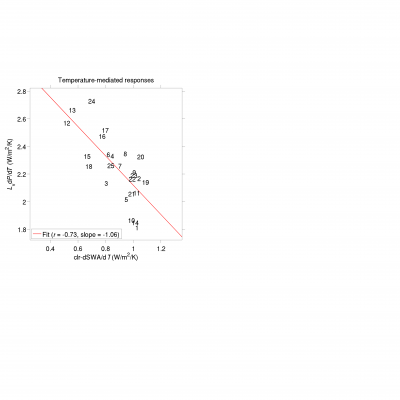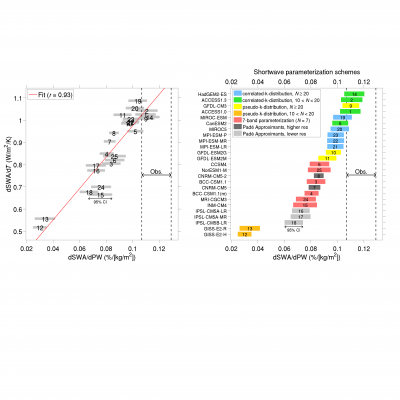An Observational Radiative Constraint on Hydrologic Cycle Intensification
Intensification of the hydrologic cycle is a key dimension of climate change that may have severe impacts on human and natural systems. A basic indicator of hydrologic cycle intensification—the increase in global-mean precipitation per unit surface warming—varies by a factor of three in current-generation climate models, and the sources of this spread remain poorly understood. We seek to better understand the spread from the perspective of the atmospheric energy budget.
In 25 models participating in phase 5 of the Coupled Model Intercomparison Project (CMIP5), we analyze the rapid adjustments and surface-warming-induced (hereafter temperature-mediated) responses of the atmospheric energy budget components (net longwave cooling, shortwave absorption, latent heat release from precipitation, and surface sensible heat flux) following an abrupt increase in atmospheric carbon dioxide.
Model spread in the temperature-mediated increase in global precipitation, which significantly contributes to spread in the total precipitation increase per unit warming, can be explained to a large extent by model differences in the warming-induced increase of clear-sky atmospheric shortwave absorption. Scatter in the shortwave absorption response originates from model differences in the sensitivity of solar absorption to a unit increase in atmospheric water vapor, which is a consequence of different radiative transfer parameterizations. An observational estimate shows that most CMIP5 models underestimate this sensitivity, implying that they underestimate the temperature-mediated increase in shortwave absorption and thus overestimate the increase in global precipitation. Attaining accurate shortwave absorption responses through radiative transfer scheme improvement could reduce model spread in the global precipitation increase per unit warming at the end of the 21st century by about 35% and reduce the estimated ensemble-mean increase in this quantity by almost 40%.
All authors are supported by the Regional and Global Climate Modeling Program of the Office of Science of the U.S. Department of Energy.


